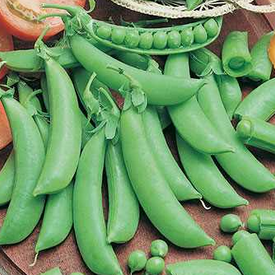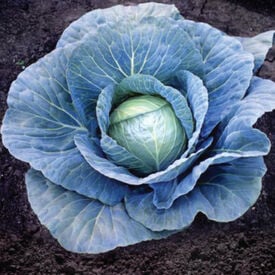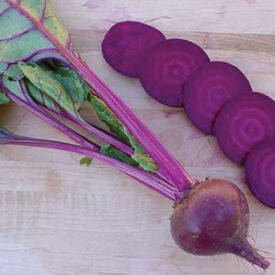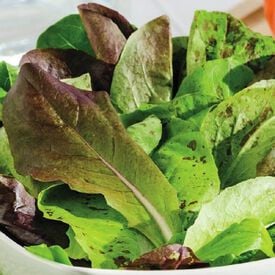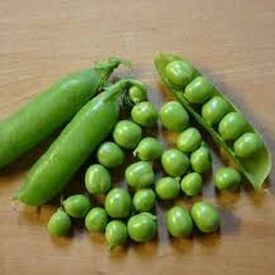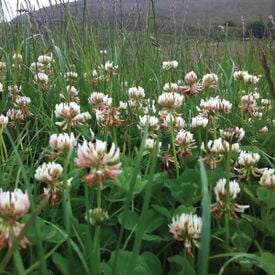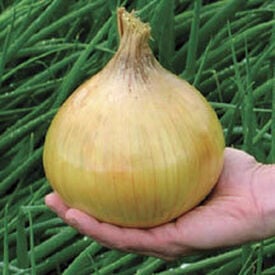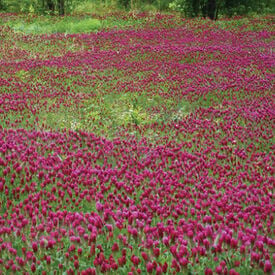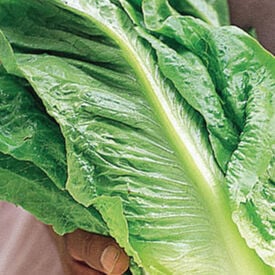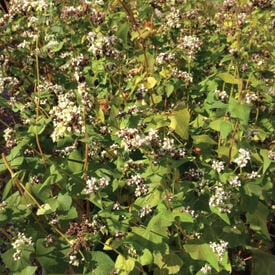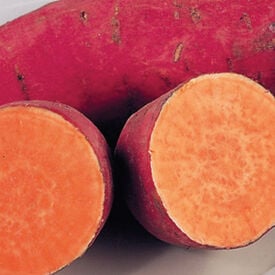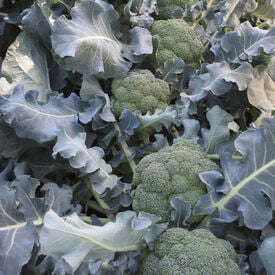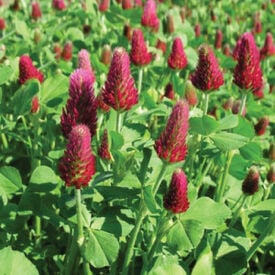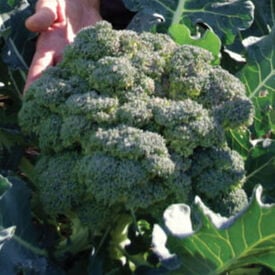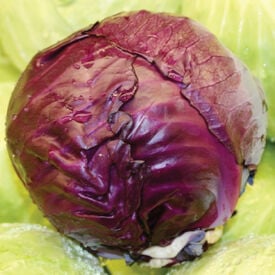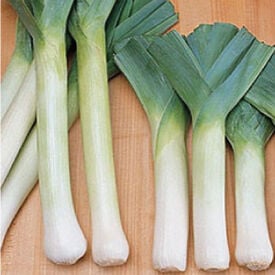Cascadia Pea is a major garden staple for its heavy yields of great tasting and crispy pea pods. Enjoy bucketloads of large, crisp pods with small, sugary peas! The 3' tall vines should be supported on a trellis or fence. Cascadia's multiple disease resistances allow for spring and late season plantings.
Blue Vantage produces dense and large heads with short cores. A mid-season maturity that is ideal for fresh eating or coleslaw. Great resistance to Fusarium yellows race 1 resistant and tipburn tolerant.
The Ruby Queen is an excellent canning and fresh eating beet! A perfectly round beet that has a smooth buttery texture that is more tender than any other beet. An early maturing beet, 52 days, that grows well in any soil type throughout the country. Ruby Queen can be grown close because they hold their shape well. They can also be grown larger than most beets and still hold good flavor making it a great market beet. An All American Selection winner!
The Romaine Trio Blend is a mixture of three of our specialty romaine lettuces. This tri-colored blend is very popular for not only its beautiful color variation and vigorous growth, but also for its delicious taste.
The Early Frosty Pea is an old heirloom that, just like its name suggests, thrives in the colder climates. This variety does great in early spring or short season plantings. The vines are cold hardy and can grow to 30." This pea plant yields 3 1/2” pods filled with 6-7 delicious medium sized peas that are excellent for fresh eating or freezing for later use.
The White Dutch Clover is a perennial clover variety that is a customer favorite for controlling erosion while protecting the soil! This legume is a living mulch of permanent cover that spreads by stolons. Grow low so takes close mowing and grazing. The White Dutch Clover benefits bees and insects as well as fixes nitrogen. Uses: Bees & Beneficial Insects, Chicken Forage, Deer Attractant, Erosion Control, Forage, Green Manure, Nitrogen Fixation, No Till, Weed Suppression
Ailsa Craig Exhibition is a large onion that has a unique mildly sweet flavor! This plant produces on the average a huge 5 lb. sweet white onion that has a delicious flavor in many dishes. Impress your neighbors and try growing this World Record sized onion.
The Medium Red Clover is fast to establish and can be grown in most soil types as well as sowed in spring, summer or fall! This clover works well for hay or silage. The Medium Red Clover can be used as a cover crop between rows of vegetable crops if mowed to maintain manageability. This clover can fix up to 150 lb. of nitrogen per acre. Uses: Bees & Beneficial Insects, Chicken Forage, Compaction Control, Deer Attractant, Erosion Control, Forage, Green Manure, Nitrogen Fixation, No Till, Weed Suppression
The Parris Island Cos is an heirloom romaine lettuce that is great for home and market gardens. This variety is a great lettuce commonly used for baby leaf production. Parris Island Cos is a fast maturing lettuce that makes an excellent tasting head. Its uniform upright, grey-green heads are 8-12" tall and have slightly savory leaves and are medium-slow to bolt.
The Common Buckwheat is a grain that can be planted late spring to early summer and improves top soil and an effective choke weed! This variety establishes quickly and matures in 60 days. This buckwheat accumulates phosphorus and and potassium for following crops and is frost sensitive. Buckwheat (Fagopyrum esculentum Moench): Cool Season, Grain, Annual, Upright growth habit, Enhances soil P availability,Crude protein: straw 5%, grain 13% Uses: Bees & Beneficial Insects, Green Manure, No Till, Organic Matter (Biomass), Weed Suppresion
Certified - The Beauregard Sweet Potato is one of the most top yielding sweet potatoes available! Beauregard is such an outstanding release that has been accepted by farmers everywhere! Chances are that this sweet potato is the variety that is available in your local market. The red-orange outside color and orange inside color make it an attractive favorite. Beauregard is quick maturing with good shape.
The Garden Leaf Blend is a colorful mix of our very popular lettuce varieties. This blend is a great mixture of lettuce varieties that mature at different times and have multiple colors to give your salad bowl a full pop of color! The Garden Leaf Blend includes Black Seeded Simpson, Oakleaf, Parris Island Cos, Tango, Red Romaine, Ruby and Lolla Rosso Darky
Godzilla is a new broccoli that produces very heavy and small-beaded heads. Leaf attachments are small and lower on the stem, allowing for quick trimming and easier harvest. Heads are fine-beaded and have very heavy florets.
The Winter Wheat is a cool weather grain that is quick to germinate, cold tolerant and is adaptable to a wide range of soils! This wheat can be sown in late summer for erosion control and tilled under in early spring to add organic matter. The Winter Wheat is winter hardy nearly anywhere, and won't go to seed until its second year of growth. Use: Erosion Control, Green Manure, Nitrogen Scavenger, No Till, Weed Suppression
The Crimson Clover is an attractive winter annual that can be planted fall or early spring and will protect and improve the soil. This good nitrogen fixer (70-150 lbs per acre per year) blooms showy crimson flowers in late spring that are an excellent source of nectar for bees. This variety inter-seeds well with grass, making it a great way to ready your vegetable garden for the spring or beautify a landscape! Not to be confused with the tough perennial clovers that can take over a meadow. Uses: Bees & Beneficial Insects, Chicken Forage, Compaction Control, Deer Attractant, Erosion Control, Forage, Green Manure, Nitrogen Fixation, No Till, Weed Suppression
The Fiesta is a beautiful, heavy yielding broccoli . Uniform plants are medium height, giving rise to 5-7" blue-green heads. Heavy yields that are disease resistant, which is definitely a reason to celebrate!
Red Express cabbage seeds produce a variety of cabbage known for its vibrant purple-red color and compact, round heads. This variety is prized for its early maturity, typically reaching harvestable size in about 60-70 days. The heads are tightly packed and dense, with crisp, tender leaves that offer a mild, sweet flavor, making it ideal for both fresh consumption in salads and slaws or for cooking. Red Express cabbage is also known for its resistance to common cabbage pests and diseases, making it a robust choice for home gardeners. Additionally, it provides a good source of vitamins A, C, and K, as well as antioxidants.
King Richard is a newer leek variety that grows well throughout the United States. This leek variety is a summer type, non-bulbing leek that grows to 12" in length. King Richard has green leaves with white inside. This leek is a very early maturer and is not sufficient for overwinter growing.
